
Epidendrum secundum, one of the crucifix orchids, is a poorly understood reed stemmed species, which Dressler (1989) describes as "the Epidendrum secundum complex." According to Dressler, there are dozens of varieties, some of which appear to deserve species rank. Arditti and Ghani note that E. secundum has the distinction of bearing the longest seeds known in the Orchidaceae, 6.0 mm long. By comparison, the seeds of E. ibaguense are only 2.9 mm long.

Epidendrum flexuosum, a reed-stemmed Epidendrum common at mid-altitudes in Central America, is a species of orchid commonly called Epidendrum imatophyllum. It grows exposed to intense sunlight in the forest canopy, particularly on Guava species. E. flexuosum bears non-resupinate lavender flowers on a congested raceme at the end of a long peduncle.
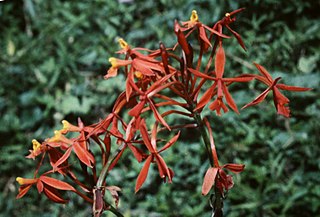
Epidendrum macrocarpum, widely known as Epidendrum schomburgkii, is a species of orchid in the genus Epidendrum, and the largest-flowering crucifix orchid species. Reichenbach thought that E. fulgens and E. schomburgkii var. confluens were both synonyms for this species.

Epidendrum ibaguense is a species of epiphytic orchid of the genus Epidendrum which occurs in Trinidad, French Guyana, Venezuela, Colombia and Northern Brazil.
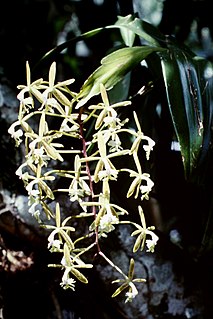
John Lindley published Epidendrum subg. Spathium of the Orchidaceae. According to Lindley's diagnosis, the E. subg. Spathium is recognizable by is sympodial habit with individual stems being slender and covered by the bases of the distichous leaves, by the lip of the flower being adnate to the column to its apex, and by the inflorescence emerging from at least one spathe, similar to nearly all members of the genus Cattleya as understood in the year 2000. Reichenbach recognized 52 species in this subgenus, of which Kew accepts 48 :
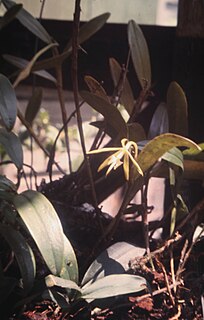
Epidendrum subsect. UmbellataRchb.f. (1861) is a subsection of section E. sect. PlanifoliaRchb.f. (1861) of subgenus E. subg. EpidendrumLindl. (1841) of the genus Epidendrum of the Orchidaceae. Plants of E. subsect. Umbellata differ from the other subsections of E. sect. Planifolia by producing inflorescences which are umbel-like. In 1861, Reichenbach recognized ten species in this subsection. Of these, nine are recognized with the same names by Kew :
Epidendrum subsect. SpathaceaRchb.f. is a subsection of the section E. sect. PlanifoliaRchb.f. 1861 of the subgenus E. subg. EpidendrumLindl. 1841 of the genus EpidendrumLindl. of the Orchidaceae. Like the other subsections of E. sect. Planifolia, the species of E. subsect. Spathacea are characterized by a sympodial growth habit without pseudobulbs, a lack of any spathes or sheathes covering the base of the racemose inflorescence, and by flat leaves. The species categorized in Spathacea differ from the members of the other subsections by having large floral bracts, which make the inflorescence resemble a strobilus. Reichenbach originally placed eight species in this subsection :
Epidendrum subsect. Racemosa is a subsection of section E. sect. Planifolia of subgenus E. subg. Epidendrum of the genus Epidendrum of the Orchidaceae. Plants of Racemosa differ from the other subsections of E. sect. Planifolia by producing inflorescences which are racemes. In 1861, Reichenbach recognized 26 species in this subsection. These names correspond to 25 species currently recognized in the World Checklist of Selected Plant Families :
Epidendrum subsect. PaniculataRchb.f. 1861 is a subsection of section E. sect. Planifolia of subgenus E. subgen. Epidendrum of the genus Epidendrum of the Orchidaceae. Plants of E. subsect. Paniculata differ from the other subsections of E. sect. Planifolia by producing paniculate inflorescences. In 1861, Reichenbach recognized eighteen species in this subsection. From this group, Kew recognizes seventeen species :
The section Epidendrum sect. Planifolia of the subgenus E. subg. EpidendrumLindl. 1841 of the genus Epidendrum of the Orchidaceae was published in 1861 by Reichenbach It differs from the other three sections by having flat leaves. Like the other sections of E. subg. Epidendrum, the inflorescence grows from the apex of the stem, and bears no spathe or sheath at the base of the peduncle.
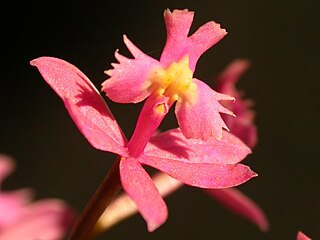
Epidendrum subsect. Tuberculata is a subsection of the section Schistochila of the subgenus AmphiglottiumLindl. of the genus Epidendrum of the Orchidaceae. This subsection differs from the subsection Integra in that the margins of the trilobate lip are dentate or lacerate. This subsection differes from the subsection Carinata by possessing a callus, or tubercule on the midlobe of the lip. In 1861, Reichenbach recognized 22 species in this subsection. Many, but not all, have since been brought into synonymy with Epidendrum secundum.

Epidendrum subsect. CarinataRchb.f. (1861) is a subsection of the section E. sect. SchistochilaRchb.f. (1861) of the subgenus E. subg. AmphiglottiumLindl. (1841) of the genus Epidendrum of the Orchidaceae. This subsection differs from the subsection E. subsect. Integra in that the margins of the trilobate lip are dentate or lacerate. This subsection differes from the subsection E. subsect. Tuberculata by possessing a keel or carina on the midlobe of the lip. In 1861, Reichenbach listed nine species in this subsection.
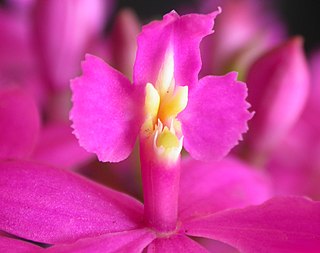
Epidendrum sect. SchistochilaRchb.f. (1861) is a section of the subgenus E. subg. AmphiglottiumLindl. (1841) of the Genus Epidendrum of the Orchidaceae. E. sect. Schistochila differs from the section E. sect. Holochila in that the species in E. sect. Holochila have undivided lips; the species in E. sect. Schistochila have lobate lips. The species in both E. sect. Schistochila and E. sect. Holochila have racemose inflorescences, unlike those in E. sect. Polycladia, which have truly paniculate inflorescences. Like the other sections of E. subg. Amphiglottium, the members of E. sect. Schistochila are sympodial orchids bearing thin stems with alternate leaves, a long peduncle covered with thin, imbricating sheathes, and a lip adnate to the very end of the column.

Epidendrum sect. PolycladiaRchb.f. 1861 is a section of the Subgenus E. subg. AmphiglottiumLindl. of the Genus Epidendrum of the Orchidaceae. This plants in this section differ from the plants in the other sections of E. subg. Amphiglottium by having truly paniculate inflorescences: the section E. sect. Holochila is characterized by racemose inflorescences and an undivided lip, and the section E. sect. Schistochila is characterized by racemose inflorescences and a lobed lip.
Epidendrum hemiscleria is a sympodial epiphytic orchid native to the tropical cloud forest of Ecuador and Peru, at altitudes near 3.3 km.
Epidendrum sect. Holochila Rchb.f. 1861 is a section of subgenus Epidendrum subg. Amphiglottium of the Orchidaceae. It differs from section E. sect. Polycladia by bearing inflorescences that are racemes, not panicles. It differs from section E. sect. Schistochila by having a lip with no lobes. Like the other sections of E. subg. Amphiglottium, plants of E. sect. Holochila exhibit slender stems covered with close imbricating sheaths which do not swell to form pseudobulbs, and terminal inflorescences covered at the base with close imbricating sheaths but without spathes.
Epidendrum smaragdinum is an epiphytic sympodial orchid native to the Neotropics. It has been found at 0.5 km above sea level in Napo, Ecuador It is also known from Brazil, French Guiana, Guyana, Peru, Suriname, and Venezuela.
The section Epidendrum sect. EquitantiaRchb.f. 1861 of the subgenus E. subg. EpidendrumLindl. 1841 of the genus Epidendrum of the Orchidaceae was published in 1861 by Reichenbach with the notation
Epidendrum subgenus Aulizeum was raised from sectional status by Lindley in 1853. According to the Latin diagnosis, this taxon included those species of Epidendrum with a multi-lobate lip adnate to the column, with pseudobulbous stems, with the flowers sessile or born on racemes or panicles. In his further English description, Lindley stated that the species in this taxon have a horn-like stem which is only leafy at the end, and racemose inflorescences. In 1861, Reichenbach listed 32 species in this subgenus; of these, Kew recognizes 31 as separate species.










